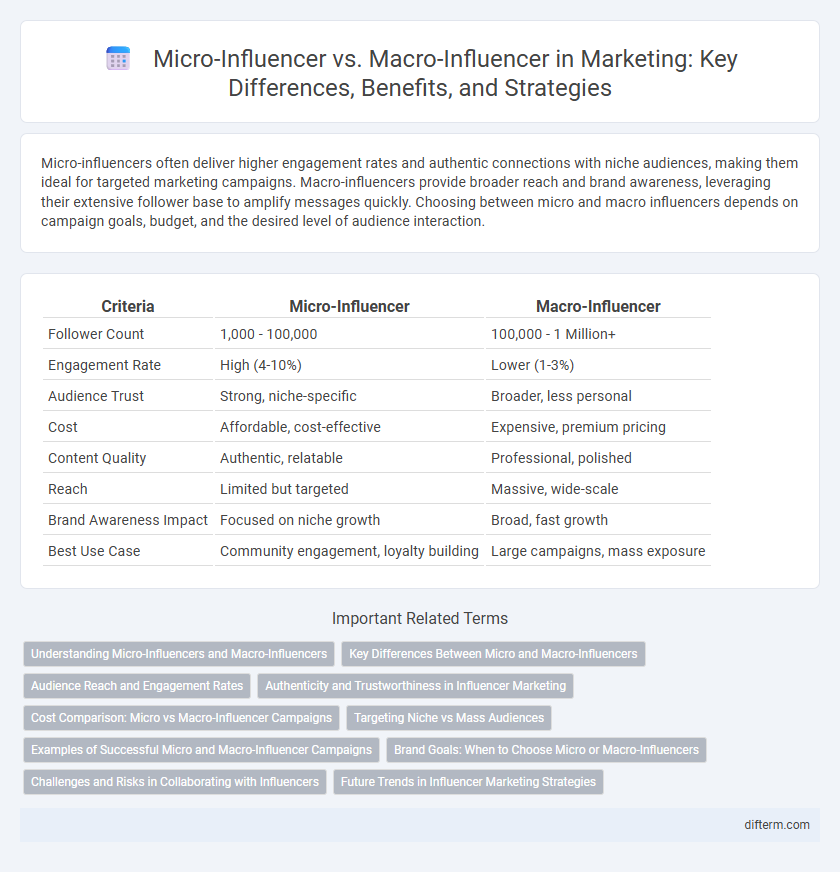Micro-influencers often deliver higher engagement rates and authentic connections with niche audiences, making them ideal for targeted marketing campaigns. Macro-influencers provide broader reach and brand awareness, leveraging their extensive follower base to amplify messages quickly. Choosing between micro and macro influencers depends on campaign goals, budget, and the desired level of audience interaction.
Table of Comparison
| Criteria | Micro-Influencer | Macro-Influencer |
|---|---|---|
| Follower Count | 1,000 - 100,000 | 100,000 - 1 Million+ |
| Engagement Rate | High (4-10%) | Lower (1-3%) |
| Audience Trust | Strong, niche-specific | Broader, less personal |
| Cost | Affordable, cost-effective | Expensive, premium pricing |
| Content Quality | Authentic, relatable | Professional, polished |
| Reach | Limited but targeted | Massive, wide-scale |
| Brand Awareness Impact | Focused on niche growth | Broad, fast growth |
| Best Use Case | Community engagement, loyalty building | Large campaigns, mass exposure |
Understanding Micro-Influencers and Macro-Influencers
Micro-influencers typically have between 10,000 to 100,000 followers, offering higher engagement rates and more niche audience targeting compared to macro-influencers who boast over 100,000 followers and broader reach. Brands leverage micro-influencers for authentic connections and cost-effective campaigns, while macro-influencers are preferred for extensive brand visibility and mainstream appeal. Effective marketing strategies balance micro-influencers' trustworthiness with macro-influencers' mass influence to maximize ROI and audience impact.
Key Differences Between Micro and Macro-Influencers
Micro-influencers typically have between 10,000 to 100,000 followers and offer higher engagement rates, often ranging from 3% to 8%, making them ideal for niche marketing campaigns targeting specific audiences. Macro-influencers, with follower counts exceeding 1 million, provide broader reach but generally exhibit lower engagement rates averaging around 1% to 3%, suited for brand awareness on a larger scale. The cost per post for micro-influencers is significantly lower, enabling brands to maximize ROI by collaborating with multiple micro-influencers versus a single macro-influencer.
Audience Reach and Engagement Rates
Micro-influencers typically have smaller but highly engaged audiences, averaging engagement rates between 3% to 8%, making them ideal for targeted marketing campaigns. Macro-influencers boast a broader audience reach, often exceeding millions of followers, but their engagement rates usually hover around 1% to 3%, which can dilute personalized audience interactions. Brands prioritize micro-influencers when authentic engagement and niche market penetration are crucial, whereas macro-influencers are favored for wide-scale brand visibility and mass awareness.
Authenticity and Trustworthiness in Influencer Marketing
Micro-influencers consistently demonstrate higher authenticity and trustworthiness due to their closer, more personal relationships with niche audiences, resulting in higher engagement rates and genuine recommendations. Macro-influencers, while offering broader reach, often face skepticism regarding sponsored content, which can dilute perceived authenticity. Brands seeking meaningful connections and credible endorsements increasingly prioritize micro-influencer partnerships to enhance campaign effectiveness and consumer trust.
Cost Comparison: Micro vs Macro-Influencer Campaigns
Micro-influencer campaigns typically cost between $100 to $1,000 per post, offering high engagement rates and targeted niche audiences. In contrast, macro-influencers charge upwards of $10,000 per post, reaching broader demographics but often with lower engagement relative to follower size. Brands seeking cost-effective marketing with personalized audience connections often prefer micro-influencers for better return on investment.
Targeting Niche vs Mass Audiences
Micro-influencers excel at targeting niche audiences with higher engagement rates and authentic connections, making them ideal for specialized marketing campaigns. Macro-influencers reach mass audiences, offering broad brand exposure but often lower engagement and less personalized interactions. Choosing between micro and macro influencers depends on whether the campaign aims for deep niche market penetration or widespread brand visibility.
Examples of Successful Micro and Macro-Influencer Campaigns
Nike's collaboration with micro-influencers in niche fitness communities led to a 25% increase in engagement by leveraging authentic, targeted content. In contrast, Adidas' macro-influencer campaign featuring global celebrity Lionel Messi amplified brand visibility to millions, driving a 40% boost in worldwide sales. These examples illustrate how micro-influencers foster deep community trust while macro-influencers deliver expansive reach for brand amplification.
Brand Goals: When to Choose Micro or Macro-Influencers
Micro-influencers excel at driving engagement and fostering authentic connections within niche audiences, making them ideal for brands aiming to boost community trust and targeted reach. Macro-influencers offer expansive visibility and are effective for brand awareness campaigns seeking rapid widespread exposure. Choosing between micro and macro-influencers depends on specific brand goals such as engagement depth, audience size, and budget constraints.
Challenges and Risks in Collaborating with Influencers
Collaborating with micro-influencers often presents challenges such as limited reach, inconsistent content quality, and the potential for low brand impact despite higher audience engagement rates. Macro-influencers pose risks including higher costs, reduced authenticity, and the difficulty of aligning with diverse audience expectations, which may dilute brand messaging. Both types require careful vetting to avoid misalignment, audience mismatch, and reputational damage due to influencer controversies or inauthentic endorsements.
Future Trends in Influencer Marketing Strategies
Micro-influencers are expected to dominate future influencer marketing strategies due to their higher engagement rates and niche audience trust, which drive authentic brand connections. Advances in AI-driven analytics will enable more precise targeting and ROI measurement, favoring micro-influencers' localized impact over broader macro-influencer reach. Brands integrating omnichannel campaigns will leverage micro-influencer partnerships to enhance personalization and foster long-term customer loyalty amidst evolving digital landscapes.
micro-influencer vs macro-influencer Infographic

 difterm.com
difterm.com